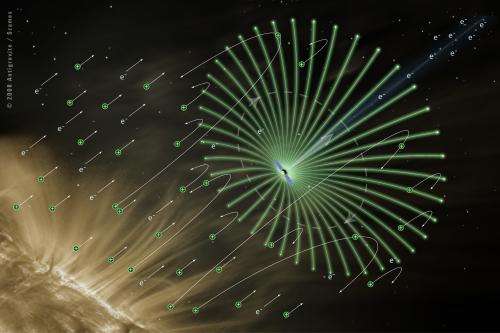Space sailing soon: A one-kilometer-long electric sail tether produced

The electric sail (ESAIL), invented by Dr. Pekka Janhunen at the Finnish Kumpula Space Centre in 2006, produces propulsion power for a spacecraft by utilizing the solar wind. The sail features electrically charged long and thin metal tethers that interact with the solar wind. Using ultrasonic welding, the Electronics Research Laboratory at the University of Helsinki successfully produced a 1 km long ESAIL tether. Four years ago, global experts in ultrasonic welding considered it impossible to weld together such thin wires. The produced tether proves that manufacturing full size ESAIL tethers is possible. The theoretically predicted electric sail force will be measured in space during 2013.
An electric solar wind sail, a.k.a electric sail, consists of long, thin (25–50 micron) electrically conductive tethers manufactured from aluminium wires. A full-scale sail can include up to 100 tethers, each 20 kilometres long. In addition, the craft will contain a high-voltage source and an electron gun that creates a positive charge in the tethers. The electric field of the charged tethers will extend approximately 100 metres into the surrounding solar wind plasma. Charged particles from the solar wind crash into this field, creating an interaction that transfers momentum from the solar wind to the spacecraft. Compared with other methods, such as ion engines, the electric sail produces a large amount of propulsion considering its mass and power requirement. Since the sail consumes no propellant, it has in principle an unlimited operating time.
The electric sail is raising a lot of interest in space circles, but until now it has been unclear whether its most important parts, i.e. the long, thin metal tethers, can be produced.
The team at the University of Helsinki is apparently the first one in the world to use ultrasonic welding to join wires together into a tether, says the team leader, Professor Edward Hæggström from the Department of Physics.
A single metal wire is not suitable as an ESAIL tether, as micrometeoroids present everywhere in space would soon cut it. Therefore the tether must be manufactured from several wires joined together every centimetre [Image 1]. In this way, micrometeoroids can cut individual wires without breaking the entire tether.
The tether factory has so far produced ultrasonic welds for one kilometre of aluminium tether
The Electronics Research Laboratory team started studying the production problem four years ago. At the time, the view of international experts in ultrasonic welding was that joining thin wires together was not possible. However, the one-kilometre-long tether produced now, featuring 90,000 ultrasonic welds, shows that the method works and that producing long electric sail tethers is possible.
The wire is produced with a fully automated tether factory, a fine mechanical device under computer control, developed and constructed by the team itself. [Image 2]. The tether factory at the Kumpula Science Campus in Helsinki, Finland, was integrated into a modified commercial ultrasonic welding device. Ultrasonic welding is widely in the electronics industry, but normally it is used for joining a wire to a base.
We have a challenging task, as keeping thin wires repeatedly in the precisely correct position is hard, says Timo Rauhala who works in the laboratory.
Approximately three metres of tether is currently produced per hour. Its quality is verified optically with a real-time measurement that inspects the connection of every individual joint. In the future, the production speed is to be raised and the weld quality will be assured during the production process.
The products of the tether factory will soon see action in space. The first opportunity will be the ESTCube-1 satellite, an Estonian small satellite to be launched in March 2013. ESTCube-1 will deploy a 15-metre long tether in space and measure the ESAIL force it is subjected to. This is ground-breaking as, so far, the theoretically predicted electric sail force has not yet been experimentally measured.
Next in turn will be the Aalto-1 small satellite from the Aalto University, to be launched in 2014, which will deploy a 100-metre long tether.
The deployed tethers are kept straight in space by the centrifugal force, the magnitude of which is five grams in a full-scale electric sail. The wire-to-wire welds of the ESAIL tether produced at the University of Helsinki will tolerate a pull of 10 grams.
More information: www.electric-sailing.fi/
Provided by University of Helsinki


















